System Impacts
| Human Behavior on System | System Impact on Humans |
|---|
Occupant Behavior on Indoor Environmental Quality
Occupant buy-in and cooperation is essential to maintaining indoor environmental quality (IEQ) and the health, financial, and human impacts associated with it . Goals can only be identified and achieved if executed hand-in-hand with the occupants.
IEQ occupant surveys are a cost effective and valuable resource for identifying areas of discomfort or dissatisfaction to address during renovation projects and to help assist the operations and maintenance team in identifying opportunities for improvement. Occupant surveys should be unbiased and encompass all components of indoor environmental quality, including air quality, thermal and lighting comfort, and acoustical privacy. The occupants’ perspective on comfort can help identify lingering issues such as excessive noise or space cleanliness. Responses to these surveys should be the focus of any renovation project, regardless if its primary goal is IEQ related, and could save wasted energy from over-lit or over-conditioned spaces. Surveys and feedback cycles should occur periodically over the life cycle of the facility to ensure the desired quality is upheld. Explore Berkeley’s Center for the Built Environment Occupant Survey![]() .
.
Occupant comfort can be optimized by providing high levels of individual or group controllability with regard to ambient air, lighting, and sound. Thermal conditions, including air temperature, humidity, and speed, should be designed to allow for personalized adjustments through integration of individual thermostat controls, localized diffusers, or operable windows. Similarly, implementing task lighting strategies at workstations creates flexibility for occupants to alter their illuminated environment. Acoustic controllability can be difficult as the distractions, such as coworker conversations, are often out of the hands of the occupant. However, providing mobility (for example laptop computers or designated "quiet areas" like in a library) and separate acoustic zones allow occupants to seek out ambient conditions beneficial to their current task.
The way occupants interact with and utilize the building space has a direct effect on overall IEQ as many times it is humans that introduce harmful airborne particulates or distracting acoustics. Environmental Tobacco Smoke (ETS) is a known carcinogen in humans, therefore smoking should be prohibited within the building and near any doors, windows, or air intake vents. Implementing an entryway mat or grate systems by exterior doors can further help remove dust that would otherwise be spread throughout the space simply by occupants walking around.
Consider creating an open acoustic policy outlining areas where team and spontaneous discussions are encourages and areas where privacy should be respected. Providing acoustical zoning in the space with corresponding signage reminding occupants of these courtesy policies and procedures will assist in limiting distractions arising from occupant behavior.
Best Practices and Strategies
| Provide placards near exterior entrances reminding visitors of the ETS smoking policy. | Train workplace specialists, maintenance staff, and occupants on the value of maintaining healthy IAQ. | Consider establishing IEQ dedicated avenues for occupants to voice complaints or concerns, and provide periodic occupant surveys. |
| Create an office policy centered on acoustical best practices to limit distractions and create public awareness. | Provide acoustical zones for different work environments with signage to remind occupants of “quiet” areas. | Institute a green cleaning plan that emphasizes the use of an entryway dirt capture system. |
| Integrate task lighting and thermal controls to leverage human behavior to promote IEQ. |
Research has demonstrated that some of the largest impacts on humans stemming from within the office building relate to chronic exposure to environmental contaminants or adverse environmental conditions. Implementing a successful IEQ strategy will directly affect occupant comfort, productivity, and health.
Studies have demonstrated likely productivity gains attributed to increased occupant comfort of 0.5 – 5% from direct improvements in the quality of the office indoor environment.1 These productivity gains in tasks such as typewriting, learning performance, reading speed, and word memory, correlate to $20-160 billion savings annually.1 See the Financial Impact section.
1. Fisk, W.J,”Health and Productivity Gains from Better Indoor Environments and Their Relationship with Building Energy Efficiency.” Annual Rev. Energy Environ. 25 (2000): 537-66
Ventilation, filtration, and the associated indoor air quality are important for maintaining occupant health and satisfaction. Providing ventilation rates at or above minimum rates prescribed in current U.S. building codes and in ASHRAE Standard 62.1-2010 - Ventilation for Acceptable Indoor Air Quality has demonstrated promising impacts on increased worker productivity and reduced absenteeism. Discuss optimal ventilation rates at the Integrative Process table to identify strategies that reach desired goals across all aspects of the project.
To optimize worker performance, treat indoor air temperature to remain within the range of 70 °F to 73 °F.1 Providing thermal controls to allow workers customization of their working environment may lead to even greater performance results.
Visit the Enhancing Health with Indoor Air page to learn more about air temperature.

Source: Lawrence Berkeley National Labs
1. DOE LBL | IAQ Scientific Findings Resource Bank - Temperature and Office Work Performance![]()
Providing daylight access and views for occupants is important in reaching performance goals as part of the IEQ strategy. According to a study done by the Light Right Consortium, lighting designs that provided direct and indirect lighting, wallwashing, and occupant dimming controls were rated as comfortable by 91% of the occupants. In the same study, significantly fewer occupants (69-71%) reported their working space as comfortable when only 2x4 downlight troffers were provided. Daylight provides an engaging and visually stimulating work environment that can lead to significant gains in productivity.
Additional studies have demonstrated that workers with better outdoor views at their workstations, compared to baseline occupants with no outdoor views, performed 16% better in memory tests.1
1. Heschong Mahone Group, Windows and offices: a study of office workers performance and the indoor environment. 2003, Prepared for California Energy Commission: Fair Oaks, CA.
It is no surprise that our physical and mental well-being is directly impacted by our environment: the air we breathe, the temperatures we feel, and the things we hear and see. A successful IEQ strategy is essential in creating a healthy office space that promotes occupant productivity.
Poor indoor air quality resulting from dusts, molds, pests, and airborne contaminants like VOCs can lead to dizziness, skin irritations, asthma, shortness of breath, and other respiratory illnesses. These conditions can become amplified after prolonged exposure to create serious health effects including flu-like symptoms, liver toxicity, or cancer. Estimates suggest that integrating IEQ best practices into office facilities may result in up to a 25% decrease in allergy symptoms among the 53 million allergy sufferers and 25 million asthmatics.1
Molds, which spawn from moisture and excessive humidity in the building, release spores that when inhaled can cause inflammation in respiratory tissue or inhibit the immune system. Studies have demonstrated an 87% increase in respiratory symptoms where mold levels in chair dust were elevated.2 More toxic molds can produce chemicals called mycotoxins that may lead to more serious conditions such as tremors, loss of coordination, and cell death.
1. EPA | Indoor Air Quality![]() 2. DOE LBL | IAQ Scientific Findings Resource Bank - Health Risk of Dampness or Mold in Workplaces and Schools
2. DOE LBL | IAQ Scientific Findings Resource Bank - Health Risk of Dampness or Mold in Workplaces and Schools![]()
Sick Building Syndrome (SBS) are symptoms that affect a person within the building, primarily office spaces, but improve when away from the building. SBS symptoms begin quickly and can include eye, nose, and throat irritation, headache, fatigue, and coughing. These adverse health effects could be reduced 20-50%, or by 16-37 million avoided cases of common cold or influenza, with conscious IEQ strategies.1
Visit the Enhancing Health with Indoor Air page to learn more about ventilation.
Best Practices and Strategies
| Create an IEQ strategy that promotes both physical and mental well-being. | Prevent adverse health effects through improved air filtration in the building ventilation system. | Continually monitor indoor CO2 concentrations through use of CO2 monitors placed at normal breathing heights (3-6ft) from the floor to ensure adequate ventilation rates. |
| Optimize ventilation rates and energy efficiency to find a comfortable, healthy, and energy efficient solution. | Provide views to the outdoors for as many occupants as possible. Consider integrating transparent wall panels and locating private offices to the interior. | Maintain cleanliness levels with Green Cleaning and Environmentally Preferable Purchasing Plans. |
| Establish ways for building occupants to report building-related health problems. |
Additional Resources
- DOE LBL | Indoor Air Quality Scientific Findings Resource Bank

- EPA | Energy Cost and IAQ Performance of Ventilation Systems and Controls

- Whole Building Design Guide | Enhance Indoor Environmental Quality (IEQ)

- EPA | Building Assessment Survey and Evaluation (BASE) Study

- EPA | Indoor Air Quality

- GSA | Wellbuilt for Wellbeing


